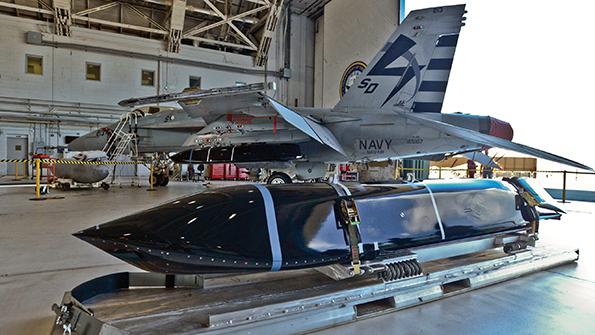
Another new variant of a stealthy Lockheed Martin cruise missile has appeared, highlighting the surging popularity of powered, expendable munitions and revealing a fundamentally vital new capability.
An Aug. 18 U.S. Naval Air Systems Command (Navair) presolicitation notice referenced the “LRASM AGM-158C-2 Strike Capability” in the public domain for the first time. Navair responded to Aviation Week questions about 10 days later, confirming that the AGM-158C-2 is the U.S. Navy’s first air-launched, land-attack cruise missile since the Boeing AGM-84K Standoff Land Attack Missile-Extended Range entered service 21 years ago.
As the name suggests, the AGM-158C-2 builds on the Long-Range Anti-Ship Missile (LRASM) program, which has fielded a maritime strike version of the U.S. Air Force’s AGM-158B Joint Air-to-Surface Missile-Extended Range (JASSM-ER) for the Navy’s Boeing F/A-18E/Fs and the Air Force’s Rockwell B-1Bs.
The baseline AGM-158C LRASM adds a radio frequency sensor for homing in on moving targets at sea and a black, anti-corrosive coating to the JASSM-ER. The AGM-158C-2 is a naval version of the JASSM-ER, with no radio frequency terminal seeker, a Navair spokeswoman said.
In fact, the presolicitation notice is the first confirmation of the Navy’s intent to follow through with a decision announced in the service’s fiscal 2022 budget request. The request revealed the Navy’s intent to buy the JASSM, likely as a replacement for the recent cancellation of a turbojet-powered version of the Raytheon AGM-154 Joint Standoff Weapon (JSOW).
The disclosure completes the Navy’s circuitous involvement in the JASSM program. An affordable, stealthy and extended-range cruise missile attractive to multiple services has been an elusive goal within the Defense Department for decades. In the mid-1990s, the Pentagon canceled the Northrop AGM-137 Tri-Service Standoff Attack Missile (TSSAM) sought by the Air Force, Navy and U.S. Army after projected unit costs nearly tripled.
The Air Force and Navy quickly launched the JASSM program in the late 1990s to replace the TSSAM, but the partnership did not last long. The Navy decided in 2004 to withdraw from the program with no direct replacement. Several years later, DARPA proved the viability of an anti-ship version of the JASSM under the Offensive Anti-Surface Warfare (OASuW) program. The Navy launched the development of the stealthy, subsonic OASuW Increment 1 in 2014, leading to the fielding of an early operational capability of LRASM five years later.
Cruise missiles of all kinds are enjoying widespread support from defense planners. The Pentagon alone plans to field the nuclear Long-Range Stand-Off for the Air Force and Sea-Launched Cruise Missile for the Navy, along with the conventional Hypersonic Attack Cruise Missile for the Air Force and the high-speed OASuW Increment 2 for the Navy within the next decade.
Indeed, the cruise missile’s popularity serves to obscure the detailed identity of the new AGM-158C-2. Navair’s description of the new weapon as a naval version of the JASSM-ER helps—but only to a point. The Air Force has fielded new versions of the JASSM-ER since it inducted the baseline in 2015. The AGM-158B-2 features a redesigned wing that enables the missile to achieve even longer range. Finally, the AGM-158D adds a weapons data link to the AGM-158B-2. It is not clear which version of JASSM-ER is the baseline for the Navy’s AGM-158C-2.
But the Navy’s revived interest in the JASSM family has revealed other capabilities. In detailed justification reports for the Navy’s fiscal 2022 budget, the service’s request for the $1.8 million AGM-158C-2 notes that the missile’s software will be converted to the C++ language. Job advertisements posted by Lockheed, meanwhile, describe an effort to recruit programmers to convert the software language for the JASSM family to C++ from Ada, an outdated language created by the Defense Department in the late 1980s.
The switch to modern, widely accepted software language for JASSM opens the door to a vast multitude of capability upgrades. As the U.S. military experiments with containerized, inflight software updates for munitions and aircraft, software developers may find C++ code friendlier to the requirements’ Kubernetes orchestration tools than the Pentagon’s obsolete Ada.






Comments